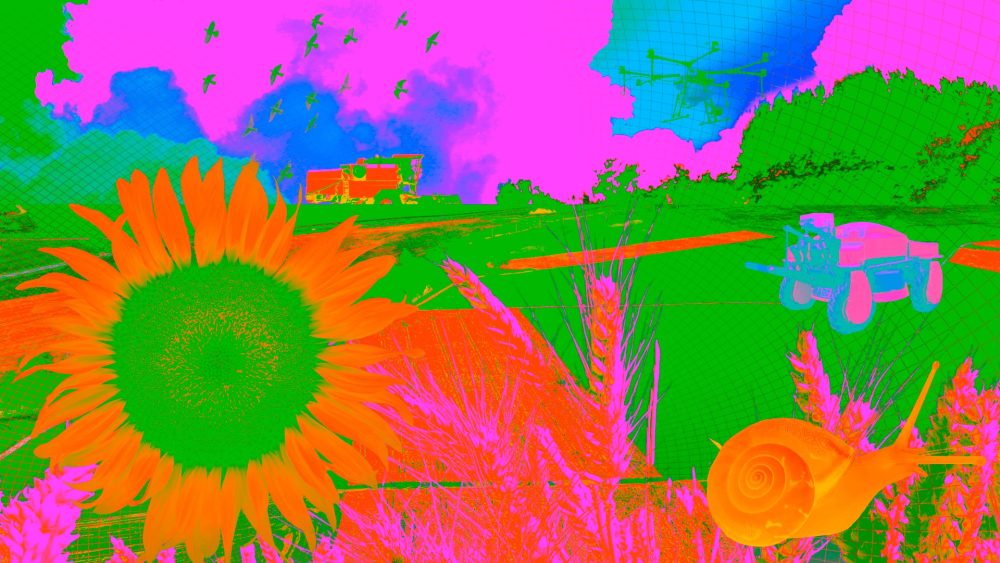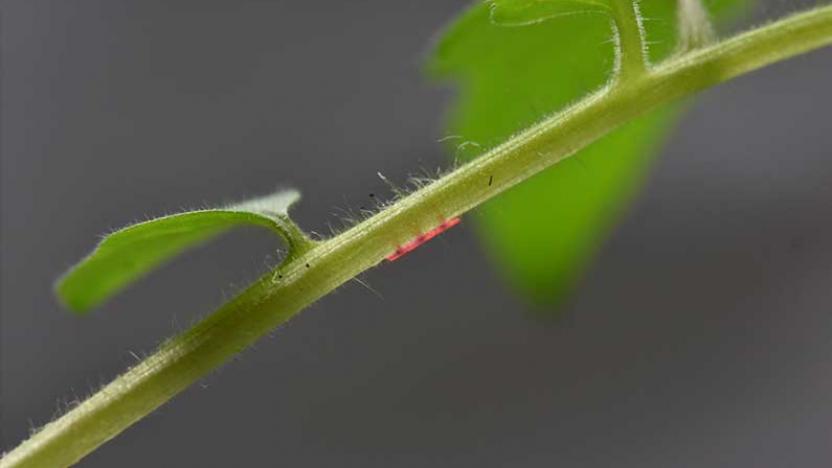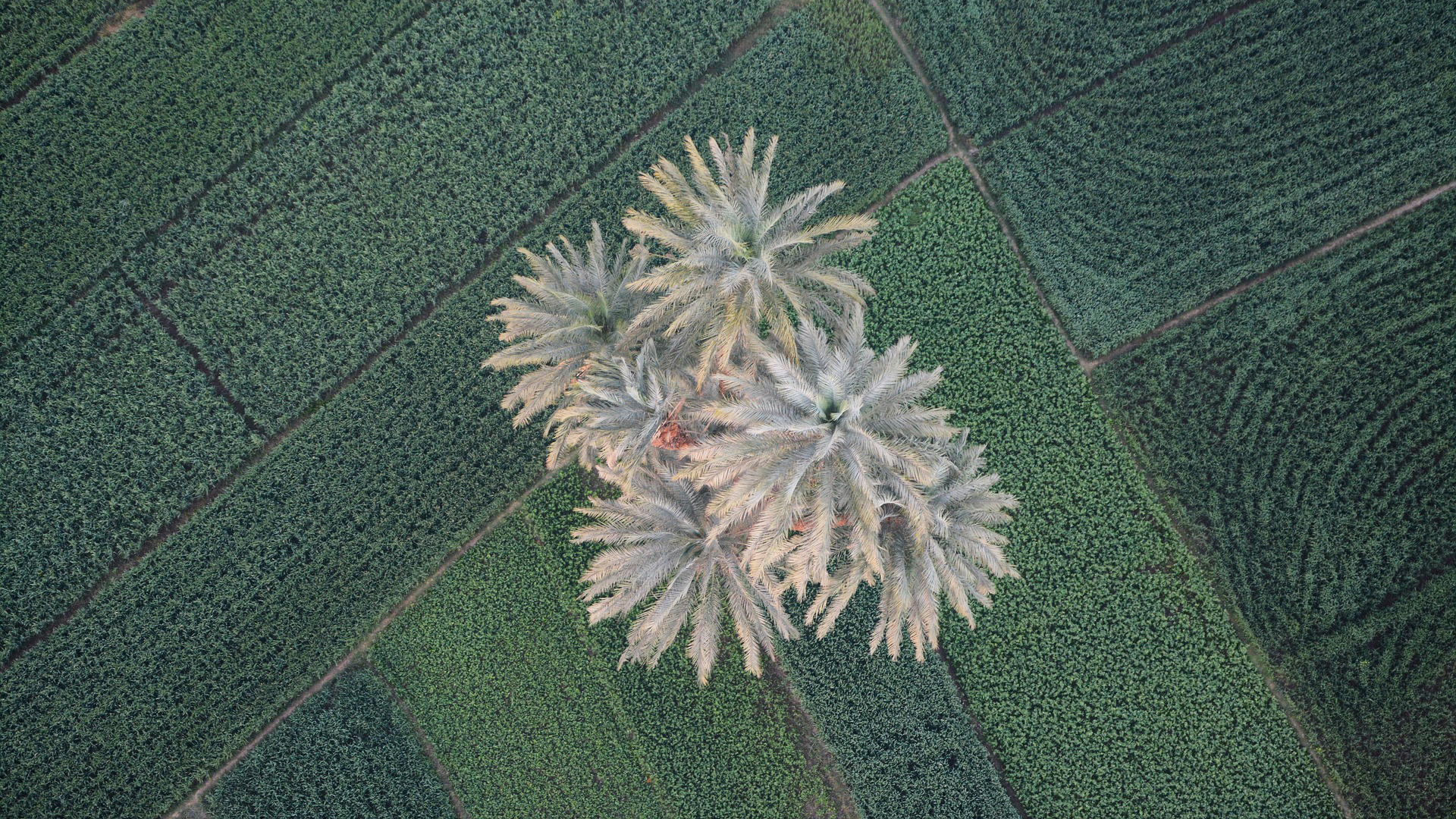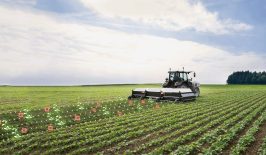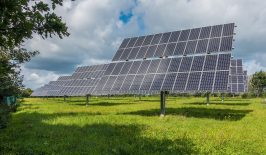Opportunities and risks of digitalisation in agriculture
From a sustainability perspective, increasing digitalisation in agriculture brings with it both potential and risks.
On the one hand, detailed information from sensors, drone or satellite data and automation can reduce the use of resources (fertilisers, pesticides, water, energy, etc) and simplify biodiversity-promoting measures. Field robots also make it easier to work on smaller areas and protect the soil.
The risks of digitalisation include rebound effects, a lack of data sovereignty and the ecological footprint of the applications themselves. These must be countered with appropriate framework conditions.
Making agriculture digital…
Digitalisation has long since arrived in agriculture. In the fields, GPS-controlled tractors take over sowing and crop care, in the barns, cows and pigs are fed by automatic machines and farms organise all processes via digital management systems.
Semi-autonomous agricultural machinery and farm management software have been used in agriculture for years. However, the pace of digitalisation has accelerated. A rapidly growing number of sensors, cloud-based IT systems and, last but not least, artificial intelligence are finding their way onto fields and farms. In Germany, France and the U.S., only around 13 percent of farmers don’t use digital technologies, and only 5 percent in Brazil. In Japan, however, around 40 percent of farmers who responded to Continental’s 2024 study that they carry out their agricultural work without digital applications.
… has what to do with sustainability, exactly?
Most digital applications in use today are aimed at reducing production costs by increasing efficiency. However, this can also have another effect—greater efficiency ideally leads to a lower use of resources. This can not only reduce costs for farmers, but also CO2 emissions and harmful environmental impacts. For example, if the routes of agricultural machinery are optimised using GPS, unnecessary routes are eliminated and less fuel is required. And if sensors, drone images and satellite images are used to determine how much water, pesticides or fertilisers a plant actually needs, these can be used in a more targeted manner and hopefully more sparingly.
In politics and science, digitalisation is therefore seen as playing a key role in the drive towards sustainable agriculture. However, despite the increased use of digital technologies, there has been no visible reduction in the environmentally harmful effects of agriculture to date. The continued massive use of pesticides and lack of protected zones is weakening many species, while the monocultures and over-fertilisation that dominate our fields are leaching the soil. This in turn can have a negative impact on agricultural yields. What’s more, is that only healthy soils and ecosystems can store large quantities of CO2 emissions.
Agriculture also contributes to the planet’s CO2 emissions. Estimates indicate that net global greenhouse gas emissions from agriculture including forestry and other land use contributed to around 21 percent of total global greenhouse gas emissions in 2024. Livestock farming is the main cause of the high emissions.
Agriculture itself is also suffering from the negative effects of climate change. As early as 2022, 67 percent of the farmers surveyed in a study by Bitkom study stated that their businesses would be affected by the consequences of climate change. Droughts, floods and other increasingly frequent weather extremes have a negative impact on yields and make farmers’ work more difficult.
It is therefore essential to dismantle and restructure the livestock industry and reduce the consumption of animal products in order to reduce emissions from agriculture. To ensure healthy soils and preserve biodiversity, the use of fertilisers and pesticides must be restricted and important biodiversity hotspots must be removed from agricultural use. Organic farming should also be strengthened and diverse, small-scale agriculture promoted.
There is broad scientific consensus on these measures. And if implemented consistently, they could not only reduce the negative effects of agriculture, but even have a positive impact on the environment and climate. This is also emphasised by agronomist Prof. Dr Sonoko Dorothea Bellingrath-Kimura from the Leibniz Centre for Agricultural Landscape Research (ZALF) in an interview with RESET. “Overall, agriculture can increase soil fertility and also improve soil structure.” It can also make an essential contribution to biodiversity and groundwater formation.
Digital solutions and their potential
On the one hand, it can be said that agriculture is becoming increasingly digitalised and that this harbours potential for environmental and climate protection. On the other, these developments do not yet appear to be bringing about the decisive agricultural turnaround everyone wanted. Why is this? What potential is not being utilised, and what are the key prerequisites for a sustainable digital agriculture revolution?
To answer these questions, we have identified promising sustainable digital solutions as part of our in depth feature, Sustainable Agriculture.
- Determining the needs of plants with precision farming
When does a plant need water or nutrients—and exactly how much? As a rule, plant nutrition is based on estimates. Precision agriculture replaces this experience with measured values from sensors, drones and satellite imagery.
The startup constellr, a Fraunhofer EMI spin-off, has been working since 2023, for example, on setting up a constellation of 16 shoebox-sized satellites that record fields from space. With the help of a new, high-precision thermal infrared measuring instrument, the technology is able to determine the health status and water requirements of crops.
Nanosensors
Nanosensors are a particularly small-scale data source that can record physiological data in real time and with pinpoint accuracy at the level of individual plants and thus contribute to the application of spot farming. However, nanosensors are not yet widespread and should rather be seen as a future development.
The application of water, fertiliser or pesticides based on this information is increasingly automated using GPS-supported guidance systems for agricultural machinery or irrigation systems. This allows plants to be controlled in an increasingly targeted manner.
According to calculations by constellr, the technology could save 180 million tonnes of water and 94 million tonnes of carbon dioxide per year globally in the future—with an increase in crop yields of up to four percent.
Sensors and cameras on the high seas: sustainable fishing thanks to “big data”?
The SUSTUNTECH research project, which is largely funded by the EU, is working on a sensor system that will enable sustainable fishing. More precise information on fish stocks and fishing success will help to shorten fishing routes and save fuel. Sensors are used both on boats and on the fishing nets. With the help of algorithms that are becoming increasingly efficient thanks to machine learning, SUSTUNTECH can link the various data together. According to a research report, this can reduce the fuel consumption of a fishing fleet by 25 to 40 percent.
Ecological potential of precision agriculture
Savings on fertilisers: Various studies have most frequently identified savings in fertilisers (Saiz-Rubio & Rovira-Más, 2020; Villa-Henriksen et al., 2020). According to a meta-study, the site-specific application of fertilisers can reduce nitrogen residues in the soil by 30 to 50 percent.
Fewer pesticides: Another major ecological potential of precision farming is the reduced use of pesticides. With conventional spraying methods, only around ten per cent of the pesticides applied actually reach diseased plants. Greater precision in application, including “spot farming” of individual plants, can have positive effects on biodiversity and reduce environmental damage.
Water consumption: The actual reduction in water consumption is more ambivalent. It is true that most of the applications analysed can reduce direct water consumption in irrigation. The aforementioned study was able to demonstrate average savings of eight percent in plant cultivation and a robot gardener was able to reduce water consumption by half. However, the variance is large.
- Field robots protect soils and biodiversity
Harvesting robots have been traversing our fields for several years now. However, currently, they fertilise and harvest food with a bulldozer rather than a velvet glove. Agricultural robots have therefore so far been exclusively suitable for robust foods such as potatoes, cereals or beetroot.
Modern robotics will change this in the next few years. The latest generation of robots uses sensors, cameras and AI software to carefully separate the ripe fruit from the plant. The picking robot from Floating Robotics can pick tomatoes without damaging them. At the same time, it has enough power to unfold fruit crates and transport them away for processing.
Another focus of robotics in agriculture is plant care. Small, autonomous robots can remove weeds and determine the health of plants. With the help of their cameras and AI, they recognise diseases and can treat the affected plants promptly and specifically.
The main task of robots in fields and stables is to reduce the amount of labour required on farms. But, they also have the potential to contribute to environmental protection.
Open source robots to replicate
Projects such as Taylor Alexander’s Acorn robot are attempting to make modern agricultural robots available to even the smallest of farms.
Alexander relies on open source software and low-cost components such as single-board computers and electric motors. Alexander does not sell these himself, but rather farmers can replicate the agricultural robot.
The code can be obtained via the Github platform.
Ecological potential of robotics
Protecting soils and biodiversity: Pesticide use is set to become much more precise thanks to robots. And if the robots destroy weeds in a targeted manner using electric shocks, agrochemicals could even become completely unnecessary. With a sufficient data basis and with the help of machine learning, robots could also specifically recognise protected plants or weed plants that serve as insect food and protect them during mechanical weed control.
Less soil compaction: Another opportunity for field robots in agriculture is that they can replace heavy agricultural machinery. Large machines compact the soil through their weight alone and promote erosion. This has a negative impact on water and nutrient cycles, the availability of oxygen and therefore also on the occurrence of microorganisms.
Smaller-scale cultivation systems with greater diversity: Field robots, but also other light and flexible machines such as drones, offer the opportunity to cultivate smaller areas with greater diversity.
However, the use of robotics is still largely in the development phase.
- Data instead of guesswork: Smart monitoring in agriculture
A project at Benha University in Egypt demonstrates the possibilities that smart monitoring can offer for the future of agriculture. The researchers used GIS data and machine learning to calculate the soil quality of a huge area in the Nile Delta. This enabled them to determine the soil quality of the Nile Delta based on a small number of samples and use the data to make specific recommendations for areas with poor soil quality.
Ecological potential of smart monitoring
Simplified soil quality measurements: Measurement methods that collect and process data using satellite data, machine learning and other digital technologies significantly simplify soil quality monitoring. In the future, fixed sensors could also provide data for regular calculations of the environmental needs of entire regions.
Improvement of ecosystem services: Smart monitoring can also be used to improve the understanding of interrelationships and ecosystem services on agricultural land. High-resolution sensors can support the classification of habitats, for example, which can be used as a basis for modelling biodiversity. This makes it possible to visualise places where birds and insects cavort and implement more targeted measures to protect them.
However, data collection and analysis with regard to biodiversity indicators is still in its infancy.
- Sustainable farm management with the help of platforms (FMIS)
Using apps and desktop applications, digital management tools help to optimise agricultural processes and manage farms more easily. For example, yields, fertiliser and pesticide application rates, machine data and site-specific data as well as weather and soil data are linked via the applications, increasingly with the help of machine learning.
However, the application of such systems is often cost-intensive, complex and not all devices and software types on a farm are compatible. There is also a risk of lock-in effects, as the platforms are predominantly provided by start-ups, multinational tech companies and food and agricultural groups. This can mean that users are tied to a specific provider ecosystem via the digital services. Once here, they are encouraged to buy other agricultural products from the provider, such as seeds, inputs and machinery, as Kevin Cussen from LiteFarm reports.
The free open-source platform LiteFarm focuses on cooperation in development and aims to achieve sustainable agriculture. All functions are specially tailored to the needs of organic farmers. Compared to many other platforms, LiteFarm offers important information for diversified farms and has a large catalogue of plants that users can expand independently and share with the LiteFarm community. The platform also offers support with the organic certification of farms.
Open source tool for solidarity agriculture
How do local farmers communicate with consumers who are looking for regional vegetables in the next town? There are many tools on the market that are associated with high costs. For many small farms and community-supported agriculture projects, these are often not affordable. The OpenOlitor association has therefore developed a free open source solution. Producers can enter their inventory in OpenOlitor and use the software as a sales platform.
Ecological potential of FMIS
Saving resources: In addition to making work easier for farmers, the consolidation of data has the potential to plan processes in line with requirements and, in the best case, to make them more efficient. This can save on fertilisers and pesticides, among other things. If the FMIS are also tailored to sustainable cultivation practices, they facilitate their use and dissemination.
Support for small farms: The platforms provide valuable support, especially for small and diversified farms, as they facilitate their management. Simplified management of agri-environmental measures: Many environmental measures are currently not accepted by female farmers because they are complicated to apply for or labour-intensive to implement. FMIS offers the opportunity to simplify applications, documentation and monitoring in the future, as all information can be collated here and forwarded automatically.
Risks of digitalisation
What the technologies mentioned in the examples have in common is that sustainable aspects such as the protection of soil and biodiversity were among the objectives of their development from the outset. This sets them apart from most other digital applications, which are primarily concerned with making agriculture more efficient and thus saving costs. Sustainability is, at best, only a side effect here.
However, while politicians and companies are focusing on digitalised agriculture’s potential, the risks are still not being given enough attention. But what exactly are they?
A major risk of digitalising agriculture is that technologies, such as precision farming and automation, have so far been used by farmers primarily to level up agricultural yields. This means that improved efficiency does not ultimately lead to savings in resources such as fertilisers and agrochemicals, but rather, these are invested directly in further increases in yield or the expansion of cultivated areas. Tilman Santarius, Professor of Socio-Ecological Transformation, has coined the term “rebound effect” to describe this. Put simply, better farming can mean more farming, with all of the chemicals and land requirements implied.
The same applies to irrigation. There is evidence that farmers are irrigating more fields and growing more water-intensive crops as a result of the more targeted distribution of water.
And if we look at field robots and drones, their advantages for cultivating small fields—their flexibility, autonomy and precision—also harbour the risk of opening up previously fallow or hard-to-reach sites. However, these ecological niches are home to many species whose habitats are being destroyed as a result.
Homogenisation of the cultivation systems:
Many digital systems are designed to optimise the cultivation of a very small number of high-yielding varieties. The high concentration in the market for digital cultivation systems further increases the risk. And the problem of lock-in effects has already been mentioned in connection with the LiteFarm project. The problem is that a low diversity of varieties can have a negative impact on the ecological resilience of agriculture, among other things.
Material and energy consumption:
If the ecological risks of digitalisation are to be considered comprehensively, the material and energy consumption of digital devices, cloud solutions and other infrastructures must also be included. However, no figures are yet available specifically for agriculture. However, material and energy consumption is likely to be rather low compared to the consumer electronics sector, for example—for now.
What is needed for sustainable agriculture?
So whether digital technologies can actually realise a potential for biodiversity and nature conservation and contribute to a reduction in CO2 emissions depends on their objective and the framework in which they are developed.
Set incentives:
Whether there is an incentive for developers to develop sustainable technologies and for farmers to utilise them depends on the political framework conditions, such as environmental regulations and subsidies. Currently, the focus here is very much on production, yield and land use. “You get premiums for agricultural use,” says Bellingrath-Kimura. “The more you produce, the better. This means that there is no incentive to become more sustainable, i.e. to use resources more efficiently or to protect biodiversity.”
In contrast, it would be important to view sustainable goals—such as the preservation of biodiversity or the storage of CO2—as management goals as well and to give them an economic value. This must be reflected in agricultural funding structures at both federal and EU level. The Green Deal and the EU’s “Farm to Fork” strategy, which aim to promote the transformation of sustainable agricultural and food systems, are at least the first important steps.
Ensure data availability and data sovereignty:
Access to and ownership of data is central to the question of whether and how digital technologies are used and who benefits from them. On the one hand, many farmers are critical of the use of their data in digital applications and services. At the same time, a comprehensive database improves the quality of the technologies and is an important basis for new developments. Clear legal requirements should therefore ensure transparency, security and fairness between farmers and technology manufacturers. This includes farmers retaining ownership of the data and being able to decide on its use themselves.
In addition, it is essential that geodata, weather data, satellite data and other data that is important for agriculture is made available and publicly accessible to farmers, research institutions and public advisory centres.
Make important data accessible
Over the last few years, the resolution of satellite images and the quality of the data have become better and better – which also benefits agriculture. The new European remote sensing satellites, which were launched as part of the Copernicus programme, play a particularly important role here. However, in order for the relevant data to really be utilised, it must be made easily available from the large data pool.
The BMEL is therefore working, for example, on the dissemination of this information through various internet offerings.
Some federal states have also implemented concepts for the provision of public geodata: farmers in Rhineland-Palatinate, for example, have free access to relevant basic geodata – such as field outlines, soil information and erosion registers – via the “MapRLP” geoportal.
Create open interfaces:
As the various examples show, there is already a wide range of technologies that make work in the fields easier and support environmental protection. For comprehensive monitoring and effective protective measures based on this, it is essential that the various digital solutions can be networked with each other across manufacturers. Open interfaces should therefore be considered right from the development stage.
Enable co-operation:
The discourse between agriculture and environmental and climate protection is often very polarised and both sides feel misunderstood. One of the reasons for this is that generalised scientific recommendations for more environmental protection do not always fit the specific situation on the ground. In addition, many farmers feel that their work is being hindered by ever more bureaucracy and regulations. The focus should therefore be on cooperation so that priorities for the digital transformation of agriculture can be jointly explored. In this way, the farmers’ experience can also be incorporated.
Advancing research:
As previously mentioned, there are many studies that deal with the opportunities of digitalisation in agriculture, but little research on the actual effects of digital applications on biodiversity, soils and climate. There is therefore an urgent need for comprehensive and independent studies both on individual digital technologies and on the overall potential of digitalisation.
Orient funding programmes towards sustainability:
Improving efficiency alone is not enough for digital technologies to really help overcome environmental challenges. Priority should therefore be given to promoting innovations that are consistently geared towards sustainability. They should also be applicable and profitable for smaller companies. Public funds in particular must be targeted and prioritised for investment in research into transformative technologies.
Closing data loops for the agriculture of the future
So what could the agriculture of the future look like in which sustainability and digitalisation go hand in hand? The vision of the future that agronomist Sonoko Bellingrath-Kimura outlined in an interview with RESET is an agriculture in which measures to protect biodiversity and species are carried out automatically, made possible by smart networking. Comprehensive monitoring using sensors and satellites makes biotopes with high biodiversity and other places worth protecting visible. “If you know that a place is very important as a biotope, you could exclude this small part from productive measures and not fertilise or spray it, for example. But then it would be best to switch off the sprayer automatically at this point without having to get out of the tractor and turn round.”
This can work if the steering systems of the tractors or robots are linked to the management and information software. And it is not only the routes of the machines that are then planned and controlled. The applications for biodiversity measures are also linked to it and transmitted automatically. Bellingrath-Kimura is convinced that this consistency will make it easier to implement many measures to protect soils and biodiversity.
As the examples should have shown, the technologies for this are already in the starting blocks. What needs to happen now is to align all digital applications to sustainability with an appropriate framework.
Finally, however, it is important to narrow things down. Of course, digitalisation alone will not bring about the total agricultural revolution that many have been asking for. That would require just the right balance of nature-based and digital solutions.
